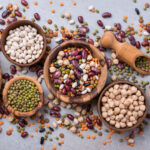by: September 24, 2024
 (NaturalHealth365) Black beans, kidney beans, lentils, chickpeas, and soybeans all share one attribute- their rich protein, fiber, minerals, and antioxidants qualify them as true “superfoods.” Officially classified as legumes, these foods are members of the Fabaceae family. (Other notable legumes include garden peas, fava beans, black-eyed peas, adzuki beans, and – somewhat surprisingly – peanuts).
(NaturalHealth365) Black beans, kidney beans, lentils, chickpeas, and soybeans all share one attribute- their rich protein, fiber, minerals, and antioxidants qualify them as true “superfoods.” Officially classified as legumes, these foods are members of the Fabaceae family. (Other notable legumes include garden peas, fava beans, black-eyed peas, adzuki beans, and – somewhat surprisingly – peanuts).
Legumes have long been valued for their outstanding nutritional profiles. Now, a new review in the Journal of the Science of Food and Agriculture points out that these hearty dietary staples contain alpha-amidase and alpha-glucosidase inhibitors – in other words, legumes are rich in compounds known to help regulate blood sugar and act against the development of type 2 diabetes. Other recent research credits legume consumption with discouraging heart disease and obesity and promoting a longer life. Read on to see what makes beans, peas, and peanuts such superbly healthy foods.
Regular legume consumption slashes mortality risk, new study suggests
Blue Zones, areas of the globe where people routinely enjoy lifespans of 100 years and more, have fascinated researchers for decades. Analysis of traditional diets in Blue Zone locations reveals that legumes play a major role in prolonging longevity. Scientists have even discovered a formula that reflects the anti-aging benefits of legumes.
In a study published in the Asia Pacific Journal of Clinical Nutrition, researchers found that every 20-gram increase in beans per day reduces mortality by 8 percent – causing the team to designate bean consumption as the “most important dietary predictor of survival” in elderly people of different ethnicities.
In one influential study published in the Journal of Nutrition, researchers found that consuming a modest half-cup of beans a day reduced the risk of heart attack by 38 percent. An NHANES (National Health and Nutrition) epidemiological study published in the Archives of Internal Medicine showed that consuming legumes four times a week was associated with a 22 percent lower risk of coronary heart disease and an 11 percent lower risk of cardiovascular disease.
Bioactive peptides in legumes can help prevent and treat diabetes, heart disease, and obesity
The 2023 review is not the only research to confirm the benefits of legumes. In a review published a year earlier in the Journal of Food Biochemistry, the authors pointed out that legumes feature bioactive peptides – small sequences of amino acids created upon protein digestion. These peptides are believed to offer a full menu of health-promoting effects, including anti-inflammatory, antioxidant, anti-obesity, and antibacterial properties, along with the ability to help prevent blood clots, regulate blood sugar, decrease cholesterol, and boost the immune system.
Incidentally, bioactive peptides work to lower blood pressure in a way similar to the pharmaceutical medications known as ACE inhibitors. Clearly, legume consumption can be a valuable weapon against the onset of high blood pressure, heart disease, and other chronic degenerative conditions.
Black beans are a stellar example of the nutritional merits of legumes
While all legumes deliver great nutrition, black beans stand out as particularly valuable. Also known as turtle beans and frijoles negros, black beans are a good source of plant-based iron, which is needed for neurological development and the synthesis of hormones. Black beans also contain healthy amounts of magnesium and potassium – important for regulating heartbeat and blood pressure – and zinc, essential for a healthy immune system.
In addition, a cup of black beans contains a whopping 16.6 grams of fiber – which can help relieve constipation, lower cholesterol, support gut microbiome health, and protect against colon cancer – along with 14.5 grams of protein needed to produce muscle, bone, cartilage, and skin. Low-cholesterol and with a low glycemic index, black beans clock in at a reasonable 220 calories a cup, allowing them to provide maximum nutritional “bang” for your caloric “buck.”
Here’s how to enhance your bean recipes
Dried beans are an inexpensive, tasty, versatile source of protein and micronutrients. During the cooking process, you can ramp up the flavor by adding sauteed garlic or onions, a drizzle of balsamic vinegar, or your favorite herbs or spices. Many holistic healthcare providers will suggest rinsing and soaking dried beans in water overnight before cooking to aid digestibility.
You can feature your favorite legumes in burritos, burgers, soup, or chili. You can also top them with salsa and serve alongside rice or quinoa or incorporate them into hummus, dips, and spreads. To encourage the absorption of beans’ plant-based iron, try to consume them alongside foods rich in vitamin C, such as peppers.
As anyone who has read “Jack and the Beanstalk” can attest, beans are associated with vibrant health and supernatural growth. Recent research on the impressive powers of legumes shows that this fairy tale just might contain a nugget of truth.
Sources for this article include:
NIH.gov
LifeExtension.com
NIH.gov
NIH.gov
NIH.gov
TheSpruceEats.com
TheSpruceEats.com
No hay comentarios:
Publicar un comentario